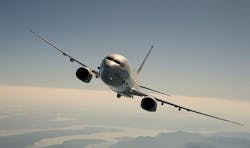Boeing to build 20 P-8A submarine hunter maritime patrol aircraft in $2.5 billion order
Officials of the Naval Air Systems Command at Patuxent River Naval Air Station, Md., announced a $2.5 billion contract modification Thursday to the Boeing Co. (NYSE:BA) in Seattle 20 Lot III full-rate production P-8A aircraft -- 16 for the Navy and four for the government of Australia.
The deal involves $2.1 billion for U.S. Navy planes, and $417 million for Australian planes. The contract modification also includes obsolescence monitoring, change assessment, and integrated baseline and program management reviews.
The P-8 is a militarized version of the Boeing 737 single-aisle jetliner hardened for long-range maritime patrol and anti-submarine warfare (ASW) missions. The P-8 is scheduled to replace the Lockheed Martin P-3 Orion maritime patrol turboprop aircraft.
Related: Navy makes order of submarine-hunting sonobuoys for helicopters and patrol aircraft
Ultimately, the Navy plans to buy 108 P-8A aircraft from Boeing to replace the service’s fleet of 196 P-3C Orion maritime patrol aircraft, which are approaching the end of operational life. The P-3 is a version of the Lockheed Martin Electra four-engine turboprop aircraft.
The P-8A is designed to operate at extremely low altitudes over the ocean during close-in searches for potentially hostile submarines. The P-8A is designed to withstand the rigors of low-altitude turbulence and exposure to salt spray.
story continues below
Navy officials plan to use the P-8A in tandem with the Northrop Grumman RQ-4N Triton Broad Area Maritime Surveillance (BAMS) unmanned aerial vehicle (UAV) -- a maritime-patrol version of the Global Hawk long-range surveillance UAV. Plans call for using BAMS to detect potentially hostile submarines and surface ships, and upon detection, to call in the P-8A to take a closer look or to attack hostile vessels with torpedoes and missiles.
Boeing is building the Poseidon aircraft at its factory in Renton, Wash. The 737 fuselage and tail sections will be built by Spirit AeroSystems in Wichita, Kan., then transferred to Renton where all structural features are incorporated in sequence during fabrication and assembly.
The P-8A’s flight management system and the stores management system have been developed by GE Aviation Systems in Grand Rapids, Mich. The cabin has as many as seven operator consoles.
Related: BAE Systems developing submarine-hunting drone sidekick for Navy P-8A
The Poseidon’s MX-20HD digital electro-optical and infrared (EO/IR) multi-spectral sensor turrets come from L-3 Communications Wescam in Burlington, Ontario. The MX-20HD is gyro-stabilized and can have as many as seven sensors, including infrared, CCDTV, image intensifier, laser rangefinder, and laser illuminator.
The aircraft has the upgraded APS-137D(V)5 maritime surveillance radar and signals intelligence (SIGINT) system from the Raytheon Co. Space and Airborne Systems (SAS) segment in McKinney, Texas.
The APS-137D(V)5 radar, which is installed on the P-8’s enlarged nose fairing, provides synthetic aperture radar (SAR) for imaging stationary ships and small vessels, coastal and overland surveillance, and high-resolution imaging synthetic aperture radar (ISAR) for imaging surfaced submarines and fast surface vessels operating in coastal waters.
Related: P-3 Orion Maritime Patrol Aircraft will fly at least two more decades
The P-8A will have the CAE Inc. advanced integrated magnetic anomaly detection (MAD) system. The Navy plans to arm the P-8A with the MK 54 torpedo.
On this contract modification Boeing will do the work in Seattle; Baltimore; Greenlawn, N.Y.; Cambridge, England; North Amityville, N.Y.; Rockford, Ill.; Rancho Santa Margarita, Calif.; Salt Lake City; and other U.S. locations, and should be finished by December 2018.
For more information contact Boeing online at www.boeing.com/defense/maritime-surveillance, or Naval Air Systems Command at www.navair.navy.mil.

